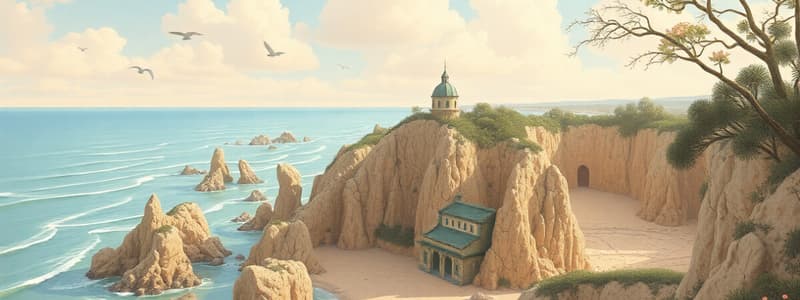Podcast
Questions and Answers
A coastline is the transitional zone where terrestrial and marine environments meet, characterized by dynamic interactions that shape its diverse features.
A coastline is the transitional zone where terrestrial and marine environments meet, characterized by dynamic interactions that shape its diverse features.
True (A)
The rate of coastal erosion is solely determined by the composition of the coastal land; softer materials like granite erode more quickly than harder materials like sandstone.
The rate of coastal erosion is solely determined by the composition of the coastal land; softer materials like granite erode more quickly than harder materials like sandstone.
False (B)
A tombolo is a coastal landform formed when a ridge of sand or pebbles joins two islands together.
A tombolo is a coastal landform formed when a ridge of sand or pebbles joins two islands together.
False (B)
Increased wave energy along coastlines always leads to an increase in sediment deposition, regardless of the beach size or shape.
Increased wave energy along coastlines always leads to an increase in sediment deposition, regardless of the beach size or shape.
Estuaries, characterized by the confluence of rivers and oceans, maintain a consistent salinity level throughout, unaffected by tidal fluctuations.
Estuaries, characterized by the confluence of rivers and oceans, maintain a consistent salinity level throughout, unaffected by tidal fluctuations.
Flashcards
What is a coastline?
What is a coastline?
The meeting point of land and the seas or oceans, including beaches, cliffs and estuaries.
What is a cliff?
What is a cliff?
A steep rock face shaped by a sea.
What is a beach?
What is a beach?
An accumulation of sand or pebbles along a coast.
What are tides?
What are tides?
Signup and view all the flashcards
What is a headland?
What is a headland?
Signup and view all the flashcards
Study Notes
- Coastlines are the meeting points of land and seas or oceans.
- Coastlines include beaches, cliffs, capes, caves, bays, and estuaries.
- These features are generally located close to each other.
Coastal Features
- Natural arch: An arch hollowed out of a headland by the sea.
- Rocky islet: A small island made of rock.
- Skerry: A rock tip just above the surface of the water.
- Spit: An elongated ridge of sand or pebbles extending into the water.
- Cliff: A steep rock face shaped by the sea.
- Sand island: An exposed summit of a sand deposit formed near or far from a shoreline.
- Headland: A tapering strip of land jutting into the sea.
- Tombolo: A ridge of sand joining an island to the shoreline.
- Beach: An accumulation of sand or pebbles along a coast.
- Dune: An accumulation of sand shaped by the wind.
- River estuary: The mouth of a river influenced by tides, forming a coastline indentation.
- Cave: A natural underground cavity resulting from the erosion of rock by water.
- Lagoon: A shallow expanse of seawater separated from the sea by a ridge of sand or a barrier island.
- Stack: A needle-shaped column resulting from a collapsed arch.
Changing Coastlines
- Waves, tides, and currents create coastlines.
- Waves erode the land and leave behind sediment.
- Coastal changes occur over long periods.
- Coastal formation depends on the material of the land and water.
- Harder materials like granite remain stable for centuries.
- Tides affect sediment deposition.
- Large tidal ranges deposit material farther inland.
- Waves carry energy and sediment depending on their size.
- Larger waves carry more energy and sediment.
- Coastlines with big beaches are able to spread out wave energy and deposits more.
- Coastlines with small beaches have focused energy.
- Sandy beaches are often washed away.
- Rocky coastlines are cracked by waves.
- Coasts help an understanding of weather and sea level changes.
- Coasts are the first places to be flooded during storms.
- Coastal plains are pieces of flat, low-lying land.
- Pollution, oil spills, and garbage affects coasts.
- Pollution negatively impacts marine life.
Weathering
- Freeze thaw weathering can cause the cliffs to breakdown
- Solution (Chemical weathering) will break down calcium carbonate (limestone) cliffs
- Plants on cliffs can cause them to breakdown
Studying That Suits You
Use AI to generate personalized quizzes and flashcards to suit your learning preferences.




